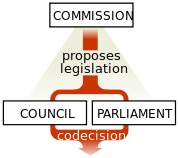Schengen Agreement

The Schengen Agreement is a treaty signed on 14 June 1985 near the town of Schengen in Luxembourg, between five of the ten member states of the European Economic Community. It was supplemented by the Convention implementing the Schengen Agreement 5 years later. Together theses treaties created Europe's borderless Schengen Area.
The 1997 Amsterdam Treaty incorporated the Schengen Agreements and the rules adopted under them into the mainstream of European Union law. The borderless zone created by the Schengen Agreements, the Schengen Area, currently consists of 25 European countries, covering a population of over 400 million people and an area of 4,312,099 square kilometres (1,664,911 sq mi).[1]
Contents |
History
The Schengen Agreement was signed on 14 June 1985 on the river-boat Princess Marie-Astrid in the middle of the river Mosel where France, Germany and Luxembourg meet. The original signatories were Belgium, France, Luxembourg, the Netherlands and West Germany.[2] It was created independently of the European Union, in part owing to the lack of consensus amongst EU members over whether the EU had the competence to abolish border controls,[3] and in part because those ready to implement the idea did not wish to wait for others. The Agreement initially only provided for the replacement of passport checks with visual surveillance of private vehicles which would be able to cross borders without stopping albeit at reduced speed.
| European Union |
 This article is part of the series: |
|
Policies and issues
|
|
Foreign relations
|
In 1990 before the Schengen Agreement had been implemented, the same five states signed a Convention implementing the Schengen Agreement. It was this Convention which created the Schengen Area through the complete abolition of border controls between Schengen states, common rules on visas, and police and judicial cooperation.
The Schengen Agreement along with its implementing Convention was not implemented under 1995, but just over two years later during the Amsterdam Intergovernmental Conference, all European Union member states except the United Kingdom and Ireland, and two non-member states Norway and Iceland had signed the Schengen Agreement. It was during those negotiations, which led to Amsterdam Treaty, that the incorporation of Schengen into the main body of European Union law was agreed along with opt-outs for Ireland and the United Kingdom that were to remain outside of the Schengen Area.
Now that the Schengen Agreement is part of the acquis communautaire, the Agreement has lost the status of a treaty which could only be amended according to its terms; instead, it can be amended by the same legislative procedure under which the rules originally adopted under the Agreement can be adopted. New EU member states do not sign the Schengen Agreement as such; instead, they are bound to implement the Schengen rules as part of the pre-existing body of EU law which every new entrant is required to accept.
See also
- Schengen Area
- Four Freedoms (European Union)
- European Union law
- Nordic Passport Union
References
- ↑ http://ec.europa.eu/justice_home/fsj/freetravel/schengen/fsj_freetravel_schengen_en.htm
- ↑ Fortress Europe, http://www.bbc.co.uk/worldservice/theneweurope/wk22.htm
- ↑ Craig, Paul; de Burca, Grainne (2003). EU Law: Text, Cases and Materials (3th ed.). Oxford: Oxford University Press. p. 751. ISBN 0-19-924943-1.
External links
- Agreement between the Governments of the States of the Benelux Economic Union, the Federal Republic of Germany and the French Republic on the gradual abolition of checks at their common borders - The Schengen Agreement
- Convention implementing the Schengen Agreement of 14 June 1985 between the Governments of the States of the Benelux Economic Union, the Federal Republic of Germany and the French Republic on the gradual abolition of checks at their common borders - Convention implementing the Schengen Agreement
- Schengen – eurotopics
- The Schengen area – European NAvigator
- The Schengen Acquis – EUR-Lex
|
||||||||||||||||||||||||||||||||||||||||||
|
||||||||||||||||||||||||||







